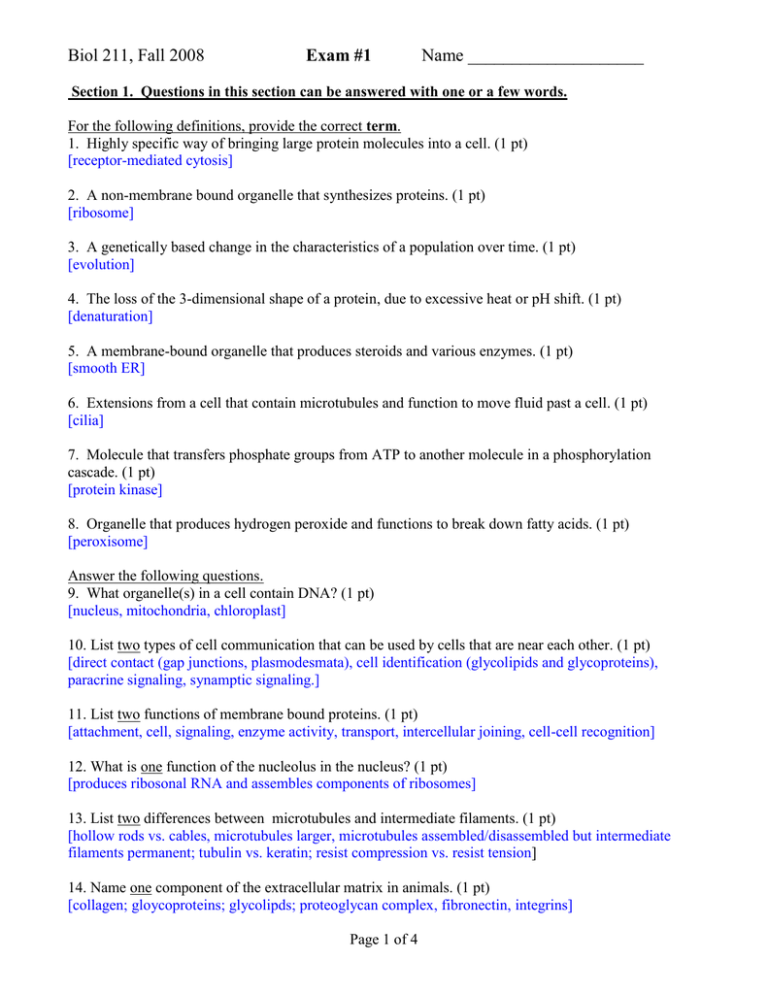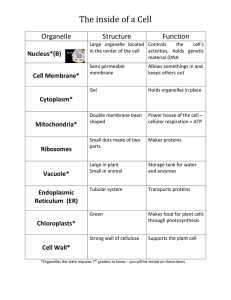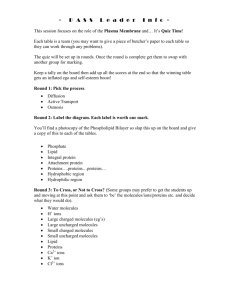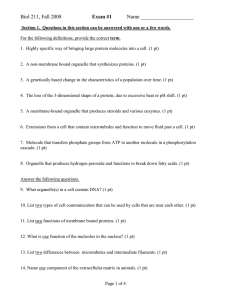Biol 211, Fall 2008 Name ____________________ Exam #1
advertisement

Biol 211, Fall 2008 Exam #1 Name ____________________ Section 1. Questions in this section can be answered with one or a few words. For the following definitions, provide the correct term. 1. Highly specific way of bringing large protein molecules into a cell. (1 pt) [receptor-mediated cytosis] 2. A non-membrane bound organelle that synthesizes proteins. (1 pt) [ribosome] 3. A genetically based change in the characteristics of a population over time. (1 pt) [evolution] 4. The loss of the 3-dimensional shape of a protein, due to excessive heat or pH shift. (1 pt) [denaturation] 5. A membrane-bound organelle that produces steroids and various enzymes. (1 pt) [smooth ER] 6. Extensions from a cell that contain microtubules and function to move fluid past a cell. (1 pt) [cilia] 7. Molecule that transfers phosphate groups from ATP to another molecule in a phosphorylation cascade. (1 pt) [protein kinase] 8. Organelle that produces hydrogen peroxide and functions to break down fatty acids. (1 pt) [peroxisome] Answer the following questions. 9. What organelle(s) in a cell contain DNA? (1 pt) [nucleus, mitochondria, chloroplast] 10. List two types of cell communication that can be used by cells that are near each other. (1 pt) [direct contact (gap junctions, plasmodesmata), cell identification (glycolipids and glycoproteins), paracrine signaling, synamptic signaling.] 11. List two functions of membrane bound proteins. (1 pt) [attachment, cell, signaling, enzyme activity, transport, intercellular joining, cell-cell recognition] 12. What is one function of the nucleolus in the nucleus? (1 pt) [produces ribosonal RNA and assembles components of ribosomes] 13. List two differences between microtubules and intermediate filaments. (1 pt) [hollow rods vs. cables, microtubules larger, microtubules assembled/disassembled but intermediate filaments permanent; tubulin vs. keratin; resist compression vs. resist tension] 14. Name one component of the extracellular matrix in animals. (1 pt) [collagen; gloycoproteins; glycolipds; proteoglycan complex, fibronectin, integrins] Page 1 of 4 Biol 211, Fall 2008 Exam #1 Name ____________________ 15. Which monomers make up a polypeptide chain? (1 pt) [amino acids] 16. Name one type of plastid found in plants and list its function. (1 pt) [chloroplast – photosynthesis; amyloplast – starch storage; chromoplast – colored pigment storage] 17. List two molecules or types of molecules that can pass through the plasma membrane by simple diffusion. (1 pt) [water, gasses, small, uncharged polar molecules] 18. Which organelle is the Cisternal Maturation Model referring to? (1 pt) [golgi apparatus] Section 2. Short Answer. Section 2. Short Answer. 19. Provide a concise definition for each that will clearly distinguish between the following pairs of terms. Be sure to include how the two terms are related to one another. (2 pts each): a) concentration gradient / electrochemical gradient [Both refer to differences in the amount of substances across an area (or across a membrane). Both are driving forces for moving molecules or ions across a plasma membrane. Concentration gradient is a difference in the number of molecules found across an area (in this case, across a plasma membrane). Electrochemical gradient includes the concentration gradient, but also the difference in charge across an area if it is referring to ions or charged molecules] b) passive transport / active transport [Both are ways to move molecules across a plasma membrane. Passive transport takes no additional energy in the form of ATP (but does require an existing concentration gradient) (Passive transport can be directly through the plasma membrane or through transport proteins, depending on what is being transported). Active transport requires the use of ATP and only occurs through transport proteins] c) discovery science / hypothesis-driven science [Both are ways of learning more about our world (doing science). Discovery science starts with observations and then builds to a general theory. It is inductive or “bottom-up” reasoning. Hypothesisdriven science starts with the general (hypothesis or theory) and then tests it. It is the basis for the scientific method, deductive or “top-down” reasoning. Page 2 of 4 Biol 211, Fall 2008 Exam #1 Name ____________________ Answer the following questions. 20. Amyloplasts are membrane-bound organelles that store starch and are typically found in cells in the roots of plants. Despite the fact that the concentrations of starch in amyloplasts are much higher than the concentration of starch in the rest of the cell, the cell is still able to move more starch into the amyloplast. How does the cell accomplish this? (3 pts) [In order to move starch into the amyloplast against its own concentration gradient, the cell must use active transport, which requires ATP. The path in is a pump, an ATP powered membrane transport protein or a cotransporter or exchanger linked to a pump. To keep the starch in, their must not be a path out (starch to big to diffuse through membrane, and also no transport proteins to move it out of the cell).] 21. How do scientists know that all life is linked evolutionarily (e.g., what are some characteristics that are shared by all forms of known life)? (3 pts) [You must have at least mentioned DNA - all organisms have DNA built from the same 4 nucleic acids. You may also have mentioned a very similar biochemistry (use (mostly) the same 20 amino acids to build proteins, amino acids all left-handed, sugars all right handed, etc.), and are carbon based – Things that were discussed in the article “Are aliens among us”. Many people just answered with what defines life – reproduction, metabolism, etc, which doesn’t answer the question.] 22. You are a researcher studying two different species of crabs. One species of crab lives in water that is at a much lower temperature than where the other crab lives. What is one difference you might expect to see in the structure of the plasma membrane between the two crab species? (3 pts) [In order to prevent the phospholipids from solidifying, the crab that lives in the lower temperature may have cholesterol or unsaturated hydrocarbons in its plasma membrane] 23. Estradiol (a small steroid hormone) is released from an endocrine gland and must travel a long distance to reach its target cell. One of its functions is to stimulate the synthesis of proteins in cells of the fallopian tubes. Describe the path the estradiol would take starting at its release from the endocrine cell and ending with the formation of a protein in the target cell. Include any steps necessary to accomplish the production of the protein after the arrival of estradiol at the target cell. (3 pts) [Estradiol is released from an endocrine cell, so would travel in the bloodstream to its target cell. It is a small steroid hormone, so would diffuse through the plasma membrane and attach to a receptor protein inside the cell, which would activate it. The activated receptor protein would act as a transcription factor (or activate one). The transcription factor would travel into the nucleus, bind with DNA, and promote the transcription of DNA to RNA. RNA (in the form of mRNA) would travel outside the nucleus to a ribosome, where a protein would be synthesized.] Page 3 of 4 Biol 211, Fall 2008 Exam #1 Name ____________________ 24. Your little brother, coming home from his junior high school biology class, tells you that “evolution isn’t real because it is just a theory”. What would you tell him about his use of the word “theory” with regard to the scientific method? (3 pts) [Many good answers. Common usage of theory is as a conjecture (not supported). A hypothesis is an educated guess. A theory has been tested many times. Etc.] 25. Starch and cellulose are both carbohydrates made from the same monomer. How are they different and what impact does this have on their function? (3 pts) [Both made of glucose, but two different types (alpha & beta). Starch is alpha, which allows it to be digestible and so is used as energy storage. Cellulose is beta, which is indigestible, so it is used structurally (in cell walls)] 26. What would be the effect on a cell if the endoplasmic reticulum stop synthesizing hydrolytic enzymes? (3 pts) [No enzymes available to be contained in a lysosome. Lysosomes would be unable to perform their functions, which includes nutrient digestion, destruction of cell invaders (bacteria) and recycling damaged organelles] Bonus Question (2pts) Answer only one of the question below. 1. What did the Davson-Danielli sandwich model attempt to explain, and what was at least one problem with the model? [Attempted to explain the structure of the plasma membrane. Stated that membranes were coated with hydrophilic proteins on both sides. Problems 1)model assumed all membranes identical, which observations of thickness did not support; 2) proteins are amphipathic, and model requires that hydrophobic portion of protein be exposed to aqueous solution. 2. What methods were used to study the role of Fus3 and Formin in directional yeast growth? [Created two mutant strains of yeast, one without the Fus 3 and one without the Formin. Used stain to make cell wall and to mark areas of new cell growth] Page 4 of 4







